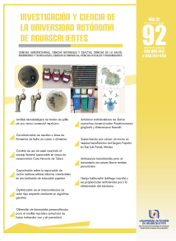Obtaining personalized biomodels of trabecular bone with and without porosity to its mechanical analysis and comparative results
DOI:
https://doi.org/10.33064/iycuaa2024924410Keywords:
Biomodels, Osteoporosis, Biomechanics, Engineering, PorosityAbstract
New computational technologies and advances in engineering have allowed the development of numerical bio-models for the simulation of biological systems (bones). These numerical models will allow for more detailed studies for timely diagnoses of conditions (osteoporosis). Biomechanics is responsible for the description of the structural components of the human body. With the design of numerical biomodels that have characteristics that resemble the real structure of bone and the use of finite elements, results will be very close to actual conditions in the human body. The numerical analysis used to simulate specific conditions is of great help to determine medical treatments or to replace biological elements with prostheses.
Downloads
References
• Caeiro, J.R., Dapía, S., Del Río, L., Carpintero, P., Esteban, G.J., Muñiz, G. (2007). Análisis morfológico, biomecánico y textural de imágenes de densitómetro central DEXA como complemento diagnóstico de la osteoporosis, Patología del aparato locomotor, 5(1), 55-67.
• Hernández, R.A., Urriolagoitia, G., Marquet, R.A., Romero, B., Mastache, O.A., Vázquez, J. A., Urriolagoitia, G. M. (2020). High Biofidelity biomodel generatedfrom three-dimensional imaging (cone-beam computed tomography): A methodological proposal, Computational and mathematical methods in medicine, 1-14, doi: 10.1155/2020/4292501. DOI: https://doi.org/10.1155/2020/4292501
• Krone, R., Schuster, P. (2006). An investigation on the importance of material anisotropy in finite-element modeling of the human femur, SAE International, 2006-01-006:1-11. DOI: https://doi.org/10.4271/2006-01-0064
• Marquet, R.A., Urriolagoitia, G., Hernández, R.A., Romero, B., Torres, C.R., Martínez, J., Urriolagoitia, G. M. (2018). The importance of biomodelling for a biomechanical analysis, MOJ Applied Bionics and Biomechanics, 2(3), 174-175, doi: 10.15406/mojabb.2018.02.00062. DOI: https://doi.org/10.15406/mojabb.2018.02.00078
• Marquet, R.A., Urriolagoitia, G., Hernández, R.A., Romero, B., Mastache, O.A., Urriolagoitia, G.M. (2021). High biofidelity 3D Biomodel reconstruction from soft and hard tissues (Knee), FEM, and 3D printing: A three-dimensional methodological proposal, BioMed Research international, 1-10, doi: 10.1155/2021/6688164. DOI: https://doi.org/10.1155/2021/6688164
• Marquet, R.A., Urriolagoitia, G., Hernández, R.A., Romero, B., Torres, C.R., Martinez, J., Urriolagoitia, G. M. (2018). The importance of bio-fidelity in the biomodelling for a biomechanical analysis, MOJ Applied Bionics and Biomechanics, 2(3),174-175, doi: 10.15406/mojabb.2018.02.00062. DOI: https://doi.org/10.15406/mojabb.2018.02.00062
• Marquet, R.A., Urriolagoitia, G., Romero, B., Hernández, R.A., Mastache, O.A., Cruz, S., Torres, A., Urriolagoitia, G. M. (2021). Numerical analysis of the ACL, with sprains of different degrees pfter trauma, Computational and mathematical methods in medicine, 1-19, doi: 10.1155/2021/2109348. DOI: https://doi.org/10.1155/2021/2109348
• Ramos, Y.M., Estrada, R., Bosch, J. A. (2013). Use of finite elements in a comparative study of two internal fixation systems for hip fractures, Revista Cubana de Ortopedia y Traumatología, 27(2),186-198.
• Serna, W., Trujillo, J.P., Rivera, J. H. (2010). Descripción del estándar DICOM para un acceso confiable a la información de las imágenes médicas, Revista Scientia et Technica, 16(45), 289-294.
• Urriolagoitia Sosa, G. (2005). Analysis of prior strain history effect on mechanical properties and residual stresses in beams, Thesis Ph.D., Oxford Brookes University.
Published
How to Cite
License
Copyright (c) 2024 Arturo Sánchez-Cervantes, Guillermo Urriolagoitia-Sosa, Beatriz Romero-Ángeles, Daniel Maya-Anaya, Jesús Manuel Germán-Carcaño, Guillermo Manuel Urriolagoitia-Calderón

This work is licensed under a Creative Commons Attribution-NonCommercial-ShareAlike 4.0 International License.
Las obras publicadas en versión electrónica de la revista están bajo la licencia Creative Commons Atribución-NoComercial-CompartirIgual 4.0 Internacional (CC BY-NC-SA 4.0)









